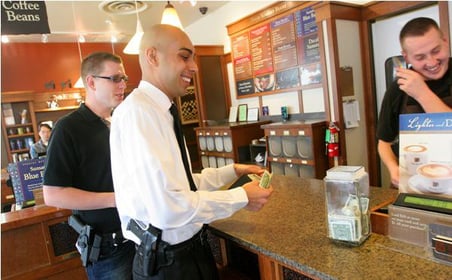When I’m weighing which gun to carry out the door, I always want the bigger gun. I love full size capabilities and I hate having to compromise down to a smaller, concealable gun. In my daily life, however, printing isn’t an option.
I carry on the job. I’m not a police officer or first responder. I don’t want to get into a debate with a random passer-by about the legality of the gun in my holster. I don’t want to be bothered. I don’t want to intimidate some potential bad guy or even give that bad guy the notion that I’m anything but just another dude going about my business.
That’s why I don’t print.
I also live in a state that acknowledges both open carry and concealed carry. If a police officer did catch a glimpse of a gun in my waistband, he probably wouldn’t say a thing unless there was a legitimate cause for concern. I’ve had police officers see I was carrying a concealed firearm by inadvertently showing it while bending down to pick up a box at work. They didn’t say a word when I handed the box to a customer.
So long as I’m not breaking the law, in my state, it doesn’t matter if I have a gun on my hip.
This is not the case everywhere. There are states that acknowledge permitted citizens’ right to carry concealed. For those people, printing isn’t just an issue of appearances — it’s a legal quandary.
To avoid this mess, it’s best to choose a handgun that fits comfortably in a concealable location. This means you have to take your body shape, stature, and posture into account. As a 5’8″ man, storing a full size handgun as an appendix carry gun isn’t comfortable.
I’ve seen a 6’4″ man carry a Ruger LCP — because that’s what he felt he could comfortably conceal and carry everywhere.
There’s a lot of factors.
But the principle terms every concealed carrier should be aware of is the difference between brandishing, showing, and printing.
The best way to describe the differences between all three is to explain them through basic scenarios.
Brandishing Example
A man gets into an argument with another man in the check-out line of a grocery store. One of the men escalates and shoves the other. The person getting shoved lifts his shirt to reveal a handgun in his waistband. This is brandishing. This is knowingly revealing the presence of a handgun to imply that it could be used.
The legal definition of this term will vary from state-to-state but the crux will usually reside somewhere around the revealing of a weapon (or firearm) with the intent to intimidate or threaten another person.
Showing Example
Like the prior incident where I bent down to pick up a box and revealed to two patrolmen in my store that I had a gun on my hip, that’s an example of showing. The officers could clearly see I had a pistol in an inside the waistband holster but it was pretty clear I neither intended to intimidate nor threaten anyone with it. That’s an example of showing.
Printing Example
So today I decided to pack my SIG SAUER X-Carry P320 with a 17-round magazine. No matter if I try putting it as appendix, 3:00 o’clock, or 6 o’clock, there’s a clear bulky outline in my waistband that is a dead giveaway I’m carrying a pistol. I’m not trying to outright reveal I have a gun but anyone with just a little common sense and some observation skills could tell I have a gun in my waistband. This is a clear example of printing.
Now, there are lesser examples or degrees of each. Legal definitions for each state are important in determining the nuance from one to the other. Some state law enforcement will take issue with revealing the presence of a concealed carry gun — through either showing, printing, or brandishing. The degree to which they react to the situation is very likely dictated on the letter of the law, their own personal perception as to whether you are acting suspiciously, and how obvious the action is demonstrated.
Printing is important if you live in a state that prefers you keep your concealed carry firearm completely hidden until needed. It can also be important if you want to maintain a concealed carry profile. Carry on.














